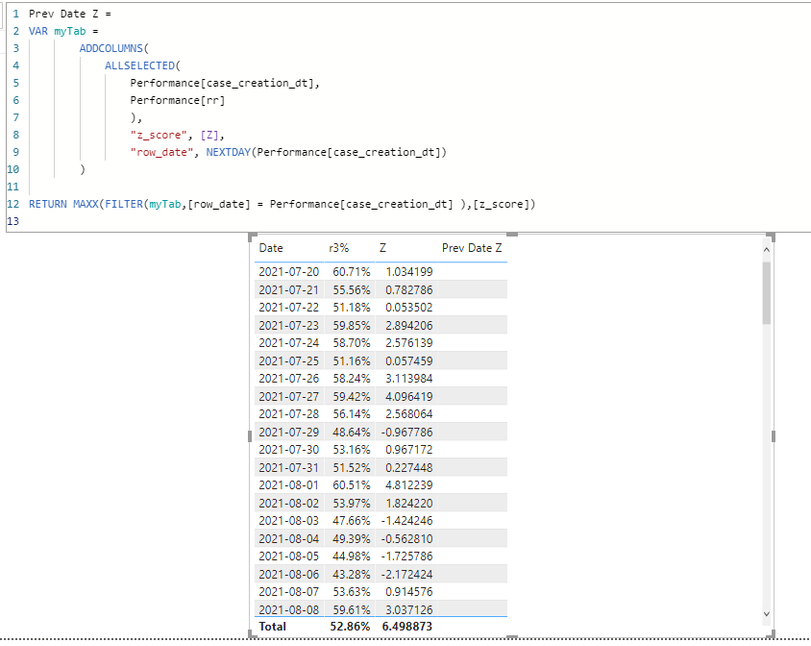Fabric Data Days starts November 4th!
Advance your Data & AI career with 50 days of live learning, dataviz contests, hands-on challenges, study groups & certifications and more!
Get registered- Power BI forums
- Get Help with Power BI
- Desktop
- Service
- Report Server
- Power Query
- Mobile Apps
- Developer
- DAX Commands and Tips
- Custom Visuals Development Discussion
- Health and Life Sciences
- Power BI Spanish forums
- Translated Spanish Desktop
- Training and Consulting
- Instructor Led Training
- Dashboard in a Day for Women, by Women
- Galleries
- Data Stories Gallery
- Themes Gallery
- Contests Gallery
- Quick Measures Gallery
- Visual Calculations Gallery
- Notebook Gallery
- Translytical Task Flow Gallery
- TMDL Gallery
- R Script Showcase
- Webinars and Video Gallery
- Ideas
- Custom Visuals Ideas (read-only)
- Issues
- Issues
- Events
- Upcoming Events
Join us at FabCon Atlanta from March 16 - 20, 2026, for the ultimate Fabric, Power BI, AI and SQL community-led event. Save $200 with code FABCOMM. Register now.
- Power BI forums
- Forums
- Get Help with Power BI
- DAX Commands and Tips
- How can I get the values from a measure for previo...
- Subscribe to RSS Feed
- Mark Topic as New
- Mark Topic as Read
- Float this Topic for Current User
- Bookmark
- Subscribe
- Printer Friendly Page
- Mark as New
- Bookmark
- Subscribe
- Mute
- Subscribe to RSS Feed
- Permalink
- Report Inappropriate Content
How can I get the values from a measure for previous date to do math on the next date?
While I understand measures don't actually exist like columns, my need here is to get the value of a measure from the date/row before current, and get the absolute delta between the two. This is for a moving range of a z score.
Above is my current measure DAX. I attempted to create a virtual table. [Z] is a measure using a couple of other measures and columns.
[Z] is calculated as:
IF([r3_den_total] < 1,BLANK(),
DIVIDE( ([r3%] - [Average R3%] ),SQRT(([Average R3%] * (1-[Average R3%]))/[r3_den_total]) )
)
As you can see in the table visual, [Prev Day Z] is returning blank.
My desired output would look like:
| Date | R3% | Z | Prev Day Z |
| 2021-07-20 | 60.71% | 1.034 | |
| 2021-07-21 | 55.56% | 0.782 | 1.034 |
| 2021-07-22 | 51.18% | 0.053 | 0.782 |
I've been hung up on this for a couple of weeks now, and any help or guidance would be immmeasurable!
Solved! Go to Solution.
- Mark as New
- Bookmark
- Subscribe
- Mute
- Subscribe to RSS Feed
- Permalink
- Report Inappropriate Content
Hi @Jphillips
It is difficult to write DAX measure without enough context, just based on your sample and your not working [Prev Day Z], your dates are consecutive, right? You may try this, please modify the Table name and Column name accordingly, AND pls provide some sample data in a format which people can copy in the future
test =
VAR PreDate=SELECTEDVALUE('yourTable'[Date])-1
VAR T1=ADDCOLUMNS(
ALLSELECTED('yourTable'[Date]),"z1",[Z])
RETURN
MAXX(FILTER(T1,[Date]=PreDate),[z1])
- Mark as New
- Bookmark
- Subscribe
- Mute
- Subscribe to RSS Feed
- Permalink
- Report Inappropriate Content
Hi @Jphillips
It is difficult to write DAX measure without enough context, just based on your sample and your not working [Prev Day Z], your dates are consecutive, right? You may try this, please modify the Table name and Column name accordingly, AND pls provide some sample data in a format which people can copy in the future
test =
VAR PreDate=SELECTEDVALUE('yourTable'[Date])-1
VAR T1=ADDCOLUMNS(
ALLSELECTED('yourTable'[Date]),"z1",[Z])
RETURN
MAXX(FILTER(T1,[Date]=PreDate),[z1])
- Mark as New
- Bookmark
- Subscribe
- Mute
- Subscribe to RSS Feed
- Permalink
- Report Inappropriate Content
@Vera_33 This worked beautifully. I'd actually come up with the below yesterday, but it doesnt seem to calculate correctly, but your query is much cleaner and easy to read. Thank you so much!
Perf R3 MR =
VAR __prevR3 =
CALCULATE ('Performance Measures'[r3%], PREVIOUSDAY('Calendar'[Date])
)
var __prevR3den =
CALCULATE('Performance Measures'[r30_den_total], PREVIOUSDAY('Calendar'[Date])
)
var __avgR3 =
CALCULATE( Performance[Average R3%], ALLSELECTED(Performance)
)
RETURN ABS( IF( __prevR3den < 1 ,BLANK(),
DIVIDE( (__prevR3 - __avgR3 ),SQRT((__avgR3 * (1- __avgR3 ))/ __prevR3den) )
) - [R3 Z] )Helpful resources

FabCon Global Hackathon
Join the Fabric FabCon Global Hackathon—running virtually through Nov 3. Open to all skill levels. $10,000 in prizes!

Power BI Monthly Update - October 2025
Check out the October 2025 Power BI update to learn about new features.

| User | Count |
|---|---|
| 11 | |
| 6 | |
| 3 | |
| 3 | |
| 3 |
| User | Count |
|---|---|
| 11 | |
| 9 | |
| 8 | |
| 8 | |
| 7 |

